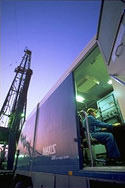The Electrical Resistivity of Materials
Electrical Logging
In the articles about the JOIDES Resolution, Making of Oil, and the CyberGeologist you read about a number of methods for finding out what is in the ground. One technique, called "electrical logging", was first developed in the 1920s by Conrad and Marcel Schlumberger. Measuring the electrical characteristics in a borehole can help reveal what's down there.
Some substances, like metals and salt water, conduct electricity well. Others, such as rubber, plastic, and glass, resist the flow of electricity. This is why the electrical cords that connect your TV and other appliances to the electrical receptacles in the wall are generally made of copper wire covered with rubber or plastic. The copper conducts the electricity to and from the appliance. The rubber prevents the wires from touching each other, causing a short circuit, or touching you, causing an electric shock.
.gif?n=4685)
Most rock does not conduct electricity well. It has a high resistivity. But in many places there is quite a bit of water that seeps into the tiny openings, or pores, that are in the rock. Often this water has salts dissolved in it and is a good conductor of electricity. Porous rock that is soaked in salt water will allow electricity to pass fairly easily because the liquid in its pores has low resistivity.
Many factors affect the resistivity of rock. Dense rock like quartz cannot hold much liquid so its resistivity will be high. Rock may be porous, but if there is petroleum or natural gas in the pores rather than water, the resistivity will be high since these hydrocarbons do not conduct electricity well. This is one reason why logging is of interest to people looking for oil.
At the right you can see some of the instruments that are lowered into a borehole to measure the electrical characteristics of the ground. These logging tools can be quite large. See how they compare to a person shown standing next to them.
|
The first electrical coring diagram |
This electric log was made in 1929 in California, just two years after the first such recording was done in France by the Schlumberger brothers. The numbers along the left side of the graph show depth below ground. The numbers across the top show resistivity. At depths of around 2000 to 2250 feet there are several peaks of high resistivity. Below 2400 feet resistivity is low
Today logging is much more complicated. The electrical properties of the ground are measured in a number of different ways. The log shown in the JOIDES Resolution article also includes what is called the Spontaneous Potential, or SP Curve and three different resistivity curves.
There are other logging techniques as well. Sound waves travel at different speeds through different substances, so engineers can use sonar to figure out what the ground is made of.
Various kinds of radiation pass more easily through some substances than others.
Lowering radioactive material into a borehole and measuring how well the radiation passes through the surrounding rock provides more information about what's down there.
In modern logging several different kinds of measurements are taken simultaneously in a borehole. Engineers look at the results of all of them together to get as full a picture as possible of what's below ground.
 This truck carries the equipment used |
 Inside the truck, an engineer monitors a logging operation. |
This content has been re-published with permission from SEED. Copyright © 2025 Schlumberger Excellence in Education Development (SEED), Inc.
Course:


